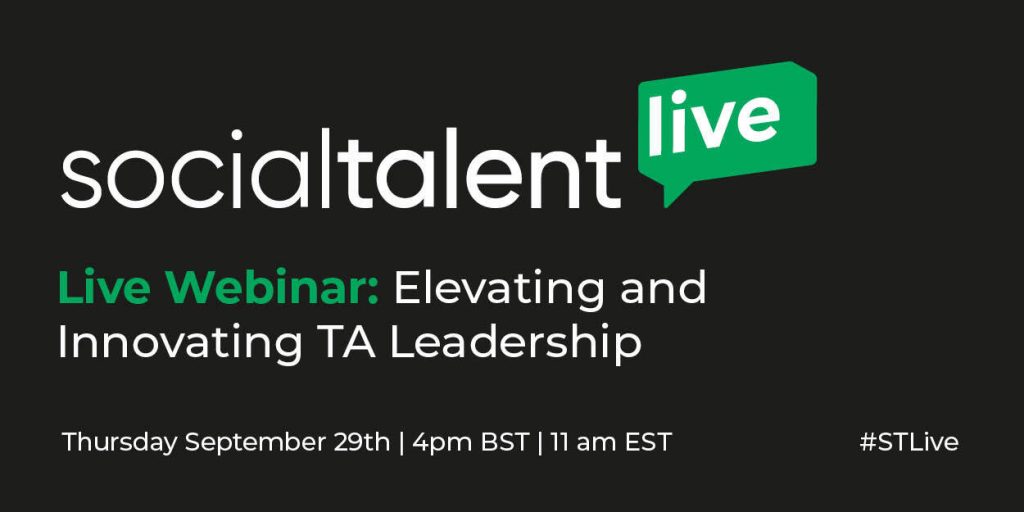
By David Deady
In this difficult hiring environment, the function of TA must continue to evolve. While hiring the best external candidates will always be the primary focus of this role, it’s becoming increasingly important for TA leaders to think about their position more holistically and strategically. In essence, they need to look at talent beyond acquisition.

What does the world of hiring look like at the moment?
According to Fortune, talent shortages are the primary threat to business success at the moment. As the skills crisis continues to be a major concern, organizations are struggling to find the employees they need to drive success. And this is true even as we teeter on the edge of economic uncertainty. Unemployment remains low and talent still has a lot of choice. It combines to create a hiring environment that is tricky to navigate. So much so that KornFerry have reported that 54% of TA leaders believe it’s harder to snag qualified talent compared with a year ago.
SocialTalent’s CEO, Johnny Campbell, recently wrote about how to find the best talent even during the skills crisis. Check it out.
What can TA leaders do to rise above this noise?
Agility is essential right now. By expanding their scope of influence beyond transactional recruiting, TA leaders have an opportunity to become changemakers within their companies. Josh Bersin research claims that only 1 in 4 orgainzations are recruiting in an optimized way. And as John Vlastelica, the Founder of Recruiting Toolbox, says: “talent problems need holistic solutions.”
In order to deliver on company hiring goals, Talent Acquisition leadership has to align itself to, and understand, other parts of the business that drive success. It can’t just be a numbers game. Joined up thinking is the most foolproof way to ensure your recruiting function not only finds the best candidates, but also increases the odds of retention.
Listen to John on our weekly podcast, The Shortlist, talk about the holistic role of TA leadership:
What areas should TA leaders look to gain more insight on?
- Internal mobility
- Onboarding
- Compensation
- Candidate experience
- EVP and employer branding
- Diversity, Equity, and Inclusion
Alignment across these avenues can ensure that every person is singing off the same song sheet. It means that the vision TA leaders are selling is mirrored in the reality of the organization as a whole. We know that candidates today have more choice and more requirements – both from a hiring and company perspective. So if TA don’t consider the rest of the business and recruit in isolation, no amount of hard work or dedication will see them achieve marked success.
According to PwC, 49% of job seekers have turned down an offer because of a bad experience. It’s also been said that 80% of TA managers believe that employer branding has a significant impact on their ability to hire great talent. While a Deloitte report found that 60% of employees believe it’s easier to find a job externally than internally.
Hiring success is based on SO much more than just getting bodies through a process. TA leaders have an opportunity to step up and become changemakers within their organizations. But how exactly can they do this?
Well, to dig into this topic in more detail, we’re delighted to announce the launch of our next SocialTalent Live event:
SocialTalent Live: Elevating and Innovating TA Leadership
Taking place on September 29, SocialTalent Live: Elevating and Innovating TA Leadership will play host to an incredible line-up of Talent and HR leaders from global companies like HelloFresh, Uber, SITA, and many more. Join us for panels and fireside chats as we look to understand how the role of TA can expand and develop. We’ll dive into the importance of innovation, the need to build a business case around TA strategy, and so much more.
Take a look at our amazing lineup of speakers:
- Michel Guye-Bergeret, Global Director Talent Acquisition, SITA
- Yasar Ahmad, Global Vice President of Talent, HelloFresh
- Roopesh Panchasra, Interim Global Head of TA, Uber
- Johnny Campbell, CEO & Co-Founder, SocialTalent
There’ll be even more speaker announcements over the next few weeks. So keep an eye out! And join us on September 29th, 4pm (London), 11am (New York).
Click here to sign up for the event



